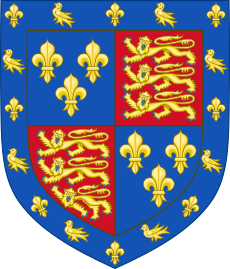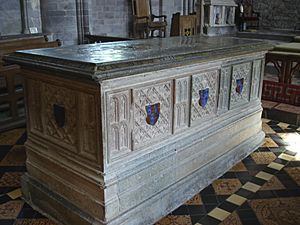Edmund Tudor, 1st Earl of Richmond facts for kids
Quick facts for kids
Edmund Tudor
|
|
|---|---|
| Earl of Richmond | |

Tomb Effigy of Edmund Tudor
|
|
| Born | c. 1430 Much Hadham Palace, Hertfordshire, England |
| Died | 3 November 1456 (aged 26) Carmarthen Castle |
| Buried | St David's Cathedral, Pembrokeshire |
| Spouse(s) | Lady Margaret Beaufort (m. 1455) |
| Issue | Henry VII of England |
| House | Tudor |
| Father | Owen Tudor |
| Mother | Catherine of Valois |
| Religion | Roman Catholicism |
Edmund Tudor, the 1st Earl of Richmond (born around 1430 – died November 3, 1456), was a very important person in English history. He was the father of Henry VII of England, who later became King. Edmund was part of the famous Tudor family from Wales.
His parents were Owen Tudor and Catherine of Valois, who was the queen mother. This made Edmund the half-brother of Henry VI of England, the King at the time. King Henry VI cared about Edmund and his brother, Jasper. He gave them special titles and land when they grew up.
Edmund and Jasper became close advisors to the King. They were the King's closest relatives. They held powerful positions in the English Parliament. Edmund also owned a successful estate and a large home called Baynard's Castle in London.
He married Margaret Beaufort, who was very young. This marriage was key because their son, Henry, would later claim the English throne. Edmund supported Richard of York when the King was ill. When the Wars of the Roses began, Edmund was sent to Wales. He was captured and sadly died from the bubonic plague in 1456.
Contents
Edmund's Early Life and Family
Edmund Tudor was born around 1430. His mother was Catherine of Valois, the queen mother. She secretly married Owen Tudor after her first husband, King Henry V of England, died. Their marriage was not widely known until after Catherine's death.
Edmund was born at Much Hadham Palace in Hertfordshire, England. This manor house belonged to the Bishop of London. In 1436, his mother went to Bermondsey Abbey. She passed away there on January 3, 1437.
After their mother died, Edmund and his brother Jasper were cared for by Katherine de la Pole. They stayed with her until at least March 1442. King Henry VI, their half-brother, then started to look after them. He made sure they received a good education from priests.
Henry VI brought Edmund, Jasper, and their father into his royal household. He seemed very fond of his half-brothers. On December 15, 1449, Henry made Edmund the Earl of Richmond. Jasper became the Earl of Pembroke a few years later.
Becoming an Earl
As Earls, Edmund and Jasper were very important in the royal court. Only Dukes had higher rank than them. They were given lands and money. Jasper received a yearly payment until he could get land in Pembrokeshire.
King Henry VI and his wife, Margaret of Anjou, had no children after seven years of marriage. This meant the royal family line was at risk. The Tudor brothers were considered as possible heirs to the throne. However, some worried because they were related to the French royal family through Catherine, but not directly to the English throne.
By 1452, Edmund and Jasper were among Henry's closest advisors. They were the only blood relatives of the King in court. They were given the job of making sure the King's power was respected in Wales. This led to the Tudor family being well-liked in Wales for a long time.
On January 5, 1453, Edmund and Jasper were formally given their titles at the Tower of London. Later that year, they took their seats in the Parliament of England. They were the most important Earls in the court. Parliament officially recognized them as the King's legitimate half-brothers. They were also given large amounts of money and property. Edmund managed his lands well and invested in the wool trade. He also received Baynard's Castle, a medieval palace in London.
The Wars of the Roses and Edmund's Marriage
In the summer of 1453, King Henry VI became very ill. He was unwell for over 17 months. During this time, different groups tried to gain power. The King's wife, Margaret of Anjou, wanted to rule as Regent. The Tudor brothers supported Richard of York, who wanted to become the "Protector of the Realm." This meant he would rule while the King was sick.
Edmund did not attend the Parliament where York was named Protector. However, he did join York's council of advisors. Both brothers were present when the council reduced the size of the Royal Household. This meant they each received their own group of staff.
The King got better around Christmas 1454. He then removed York from power, which caused a lot of tension. This put the Tudor brothers in a difficult spot. Edmund was not at the First Battle of St Albans in May 1455. In this battle, Henry was captured by Richard of York. Both brothers attended the next Parliament, where York was again named Protector. York canceled most of the grants Henry had made, but those given to Edmund and Jasper were kept.
Edmund was sent to Wales to stop a rebellion led by Gruffudd ap Nicolas. While he was there, the King removed York from power again. In response, York sent 2,000 soldiers to take control of South Wales.
Margaret Beaufort was the only child of John Beaufort, 1st Duke of Somerset. Through her father, she was a great-granddaughter of John of Gaunt. This meant she had a claim to the English throne. She was married as a child, but that marriage was ended in early 1453. On March 24, Edmund was given the responsibility of looking after Margaret, who was only nine years old.
Edmund married Margaret on November 1, 1455, at Bletsoe Castle. It was through Margaret that Edmund's son would later claim the English throne. Edmund died about a year later. He left Margaret, who was only 13 years old and seven months pregnant with their child, Henry Tudor.
Capture and Death
While Edmund was in Wales, Gruffudd captured several castles. But Edmund's forces soon took them back. However, the King had removed York from power. So, York sent soldiers to South Wales. These soldiers captured Carmarthen Castle and took Edmund Tudor prisoner.
Edmund was held in Carmarthen Castle. On November 3, 1456, he became sick with the bubonic plague and died there. He was buried at a church in Carmarthen. Later, in 1539, his remains were moved to St David's Cathedral in Pembrokeshire. This happened because his grandson, King Henry VIII, ordered the closing of many monasteries.
See also
 In Spanish: Edmundo Tudor para niños
In Spanish: Edmundo Tudor para niños



